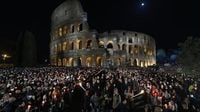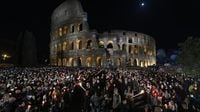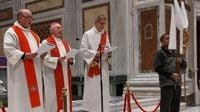On Good Friday, April 18, 2025, the faithful gathered at the Colosseum for the traditional Via Crucis, led by Cardinal Baldo Reina on behalf of Pope Francis. Though physically absent, the Pope's presence was deeply felt through his powerful meditations, which offered a stark and moving reflection on Christ's Passion in the context of today's troubled world.
Pope Francis called on believers to rediscover "God's economy" in a world shaped by "calculation and algorithms, cold logic and implacable interests." At the heart of these meditations was a bold message: in an age of inhuman systems and relentless efficiency, only a radical return to the self-giving love of Christ can offer true change. "The Stations of the Cross," the Pope wrote, "is the prayer of people on the move," a journey inward that disrupts routine and challenges comfort.
In Station I, the Pope drew attention to the "drama of human freedom," reflecting on how easily people cling to power and self-interest. He reminded listeners that Jesus' silent love stands in contrast to the noise of prejudice and judgment: "He does not wash His hands of us—He loves in silence." The falls of Jesus (Stations III and VII) became metaphors for the human condition. Francis wrote poignantly that heaven "hangs low," accessible even in our failures. "Fall and rise again," he urged, emphasizing that in our weaknesses lies the hope of new beginnings.
In contrast to today's systems that calculate value and discard the weak, God's economy prioritizes mercy over merit, inclusion over exclusion. The Pope's reflections also honored those who walk quietly beside suffering. Simon of Cyrene, unexpectedly called to carry the cross in Station V, reveals how God often meets us in unsought moments. "Though Simon did not ask for the cross, he bore it," Francis wrote, showing that service, when accepted, becomes grace.
Women also featured prominently in the Pope's meditations—Mary, Veronica, and the women of Jerusalem were depicted not only as mourners but as active participants in salvation's story. Mary, "the first disciple," is a model of unwavering trust; Veronica, who wiped Christ's face, exemplifies intimate love in action; and the women of Jerusalem are called to shed sincere tears for a world that still bleeds.
Pope Francis described the Cross as a place of reconciliation and intercession. "Nailed to the Cross," Christ places Himself "between conflicting parties," breaking down barriers and cancelling debts. He is the "true Jubilee," the embodiment of God's mercy and the source of human renewal. "In His gift," the Pope wrote, "everything blossoms anew." At Station XIII, Jesus' body is entrusted to Joseph of Arimathea, a man described as still hoping against the darkness. His quiet courage offers inspiration for all who work for good amid injustice.
Station XIV, Holy Saturday's solemn silence, becomes a lesson in "waiting"—a spiritual discipline in a world obsessed with instant results. Throughout, Francis urged believers to see the world through Christ's eyes: not as a system to master, but as a creation to love. "We have walked the Stations of the Cross," he concluded, "we have turned towards the love from which nothing can ever separate us." The meditations ended with a prayer from Saint Francis of Assisi—a plea for inner transformation and grace: "Cast your light into the darkness of my heart… Grant me right faith, firm hope, perfect charity."
In this year marked as a Jubilee, Pope Francis' Good Friday reflections call the Church—and the world—to a deeper conversion. It is a call to abandon the idol of efficiency, to embrace the inconvenient demands of love, and to rediscover the radical simplicity of a God who, in Christ, stoops to wash feet and bear crosses.
Pope Francis' Via Crucis meditations focus on Christ's sufferings on the way to Calvary during Easter 2025. The Way of the Cross is a descent Jesus undertook "toward this world that God loves" (Station II). He invites us to understand "God's economy," which "does not kill, discard or crush." Christ accepted the cross for humanity, and the Stations of the Cross is the prayer of people on the move.
Jesus' sentence of death prompts reflection on the "dramatic interplay of our individual freedoms" (Station I). At the Third Station, Jesus "falls the first time," teaching that "the Way of the Cross is traced close to the earth: the mighty withdraw from it, yearning for heaven. Yet heaven hangs low, and we can find it even in our falls." At His second fall (Station VII), Christ shows us "fall and rise again; fall and rise again," the human adventure of sin and conversion.
In Simon of Cyrene (Station V), "they laid the cross on him," illustrating how we can stumble upon God unexpectedly. Though Simon did not ask for the cross, he bore it. Christ's yoke is "easy, and His burden is light," and He loves involving us in His work that "ploughs the earth so that it may be sown anew." We need that surprising lightness. Without God, toil is in vain; "On the way of the cross, the new Jerusalem is rising."
Stations IV, VI, and VIII highlight women: Mary, Veronica, and the daughters of Jerusalem. Mary's discipleship is "not a sacrifice but a continuous discovery." She, "the first disciple," shows that "In God, words are deeds, promises are realities." Veronica's veil bears Christ's face—the proof of "His decision to love us to the last breath, and even beyond," for "love is as strong as death." And the daughters of Jerusalem, moved to weep, are urged to weep "for themselves and their children," for our wounded coexistence, our broken world calls "for tears that are heartfelt and not merely perfunctory."
At Station XIII, Joseph of Arimathea, "a good and righteous man … waiting expectantly for the kingdom of God," takes Jesus' body. Christ is "in the hands of someone who continues to hope, one of those who refuse to think that injustice always prevails," granting "great responsibilities," emboldening us. Finally, at Station XIV, the Sabbath silence of Holy Saturday: "Teach us how to do nothing at those times when it is asked of us only to wait. Teach us sensitivity to the seasons of the earth." Jesus, "laid in the tomb," shares in our human condition, descending into the depths we fear, teaching rest, anticipation, and preparing all creation for resurrection peace.
In conclusion, the meditations culminate in a prayer from Saint Francis of Assisi: "Laudato sì, mi’ Signore'—'Praise be to you, my Lord.' In Saint Francis of Assisi's canticle, our common home is a sister who cries out because of the harm we have inflicted on her. 'Fratelli tutti'—'Brothers and sisters all,' the Pope writes, calling us to be marked by the flavour of the Gospel, 'He loved us,' wrote Saint Paul, 'to make us realise that nothing can ever ‘separate us’ from that love.' We have walked the Stations of the Cross. We have turned towards the love from which nothing can ever separate us. Now, as the King sleeps and a great silence descends upon all the earth, let us pray, in the words of Saint Francis, for the gift of heartfelt conversion.






